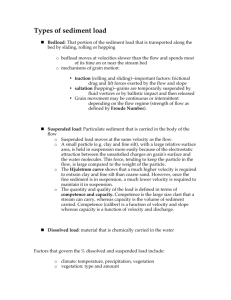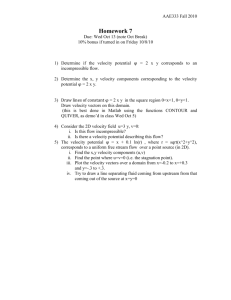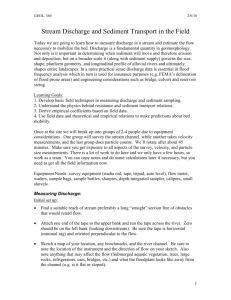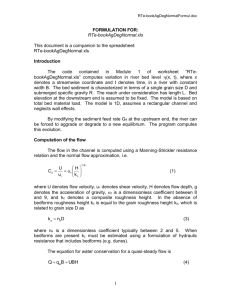RTe-bookSuspSedStrat
advertisement
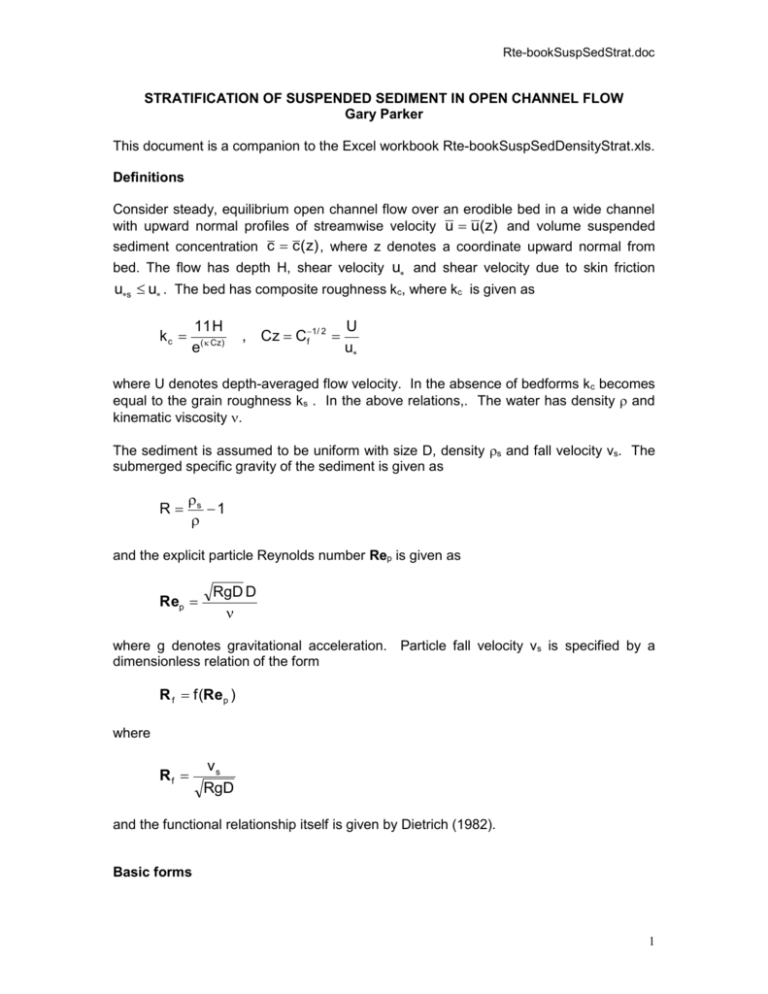
Rte-bookSuspSedStrat.doc STRATIFICATION OF SUSPENDED SEDIMENT IN OPEN CHANNEL FLOW Gary Parker This document is a companion to the Excel workbook Rte-bookSuspSedDensityStrat.xls. Definitions Consider steady, equilibrium open channel flow over an erodible bed in a wide channel with upward normal profiles of streamwise velocity u u( z) and volume suspended sediment concentration c c ( z) , where z denotes a coordinate upward normal from bed. The flow has depth H, shear velocity u and shear velocity due to skin friction us u . The bed has composite roughness kc, where kc is given as 11 H e( Cz) kc , Cz Cf 1/ 2 U u where U denotes depth-averaged flow velocity. In the absence of bedforms k c becomes equal to the grain roughness ks . In the above relations,. The water has density and kinematic viscosity . The sediment is assumed to be uniform with size D, density s and fall velocity vs. The submerged specific gravity of the sediment is given as R s 1 and the explicit particle Reynolds number Rep is given as Rep RgD D where g denotes gravitational acceleration. Particle fall velocity vs is specified by a dimensionless relation of the form R f f (Rep ) where Rf vs RgD and the functional relationship itself is given by Dietrich (1982). Basic forms 1 Rte-bookSuspSedStrat.doc The equation of momentum conservation for the flow takes the form t du z u2 (1 ) dz H (1) where t denotes a kinematic eddy viscosity. The corresponding form for conservation of suspended sediment is v sc t dc 0 dz (2) Eddy viscosity t is specified in the following form: t uH F1( ) F2 (Ri) (3) where denotes the Karman constant, F1 and F2 are specified functions, z H and Ri denotes the gradient Richardson number, given by dc Ri Rg dz 2 du dz (4) The bottom boundary condition for velocity is determined by a match to the rough logarithmic law at normalized reference bed elevation r: u r u 1 H n(30r ) kc (5) where denotes the Karman constant (0.4). The bottom boundary condition for concentration of suspended sediment is likewise given in terms of a specification of reference bed concentration cr at r. In the implementation of the workbook r is set equal to 0.05. Dimensionless forms Define dimensionless velocity and concentration as follows: u u u c c cr 2 Rte-bookSuspSedStrat.doc Equations (1), (2), (4) and (5) can then be reduced to du (1 ) d F1 ( )F2 (Ri) (6) dc 1 1 c d u r F1 ()F2 (Ri) (7) Ri Ri dc d du d (8) 2 u 1 H n(30r ) kc (9) ur u vs (10a,b) r where Ri RgH cr u2 In addition, the near-bed condition for normalized concentration c becomes c 1 (11) r Forms for the functions F1 and F2 The standard form for the function F1 is the parabolic one F1 (1 ) (12) Smith and McLean (1977) offer the alternative form F1 1.32892 2 16.86321 3 25.22663 4 r 0.3 2 3 0.3 1 0.160552 0.075605 0.1305618 0.1055945 Gelfenbaum and Smith (1986) offer the alternative form F1 exp( 3.2 2 2 3.2 2 ) 3 3 Rte-bookSuspSedStrat.doc Smith and McLean (1977) provide the following form for F2: F2 1 4.7 Ri Gelfenbaum and Smith (1986) offer the alternative below: F2 1 1 10.0 X X 1.35 Ri 1 1.35 Ri (13) Relations (12) and (13) are used in the implementation of the workbook. Form for near-bed concentration The workbook allows two options for near-bed concentration. Either it can be specified by the user, or it can be computed using the relation of Garcia and Parker (1991). In the latter case, the specification for reference concentration is as follows; cr AX5e A 5 1 Xe 0.3 Xe us Rep0.6 vs where A = 1.3x10-7. Note that if the entrainment relation of Garcia and Parker is used, it is necessary to know both u and us , where u*s denotes the shear velocity due to skin friction only. This requires the use of a resistance predictor that includes the effect of bedforms when they are present. Solution The solution used in the spreadsheet uses the parabolic form (12) for F1, the form (13) for F2 due to Gelfenbaum and Smith (1986) and the form for cr due to Garcia and Parker (1991). The solution is implemented iteratively. In the zeroth-order solution F2 is set equal to 1, corresponding to vanishing stratification (Ri = 0). This yields the solution 1 u 1 H n(30 ) ks (1 ) / ur c (1 r ) r The above solution is then used to compute Ri, which is found after some manipulation to take the form Ri Ri F2 c ur (1 ) This in turn allows for an update of F2, and thus the solution for u and c. The solution is iterated until convergence is obtained. 4 Rte-bookSuspSedStrat.doc The iterative scheme is implemented as follows. iterations for u and c, respectively, and let Ri(n 1) Ri F2(n1) Let u(n) and c(n) denote the nth F1F2(n) (n) c ur (1 )2 1 1 10.0 X X 1.35 Ri(n1) 1 1.35 Ri(n1) Equations (6) and (7) subject to (9) and (11) yield the following forms for the (n+1)th iteration. u (n 1) 1 H (1 ) n(r ) d r F ()F( n 1) ks 1 2 1 1 c (n 1) exp d r u F ()F(n 1) r 1 2 The calculation is commenced with the logarithmic law for flow velocity and the RouseVanoni solution for suspended sediment concentration; 1 u (1) 1 H n(30 ) , c (1) ks (1 ) / ur (1 r )r , F2(1) 1 The iteration is continued until u(n+1) is acceptably close to u(n) and c(n+1) is acceptably close to c(n). Note: the iterative scheme is not always guaranteed to converge! References Dietrich, W. E. 1982 Settling velocity of natural particles. Water Resources Research, 18(6), 1615-1626. Garcia, M. and Parker, G. 1991 Entrainment of bed sediment into suspension. J. Hydraul. Engrg., ASCE, 117(4), 414-435. Gelfenbaum, G. and Smith, J. D. 1986 Experimental evaluation of a generalized suspended-sediment transport theory. In Shelf and Sandstones, Canadian Society of Petroleum Geologists Memoir II, Knight, R. J. and McLean, J. R., eds., 133 – 144. Smith, J. D. and McLean, S. R. 1977 Spatially averaged flow over a wavy surface. J. Geophys. Res., 82(2), 1735-1746. 5
